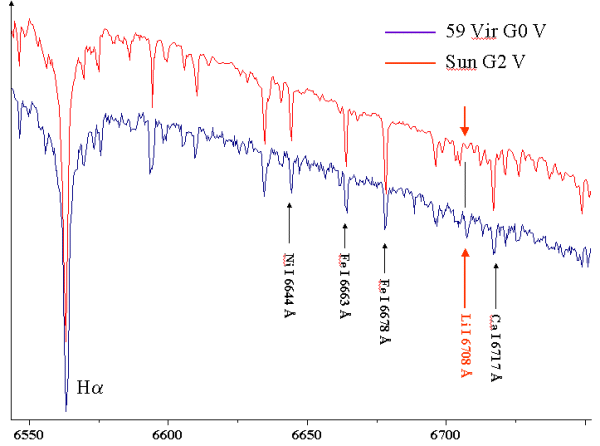YOUNG STAR SPECTRA
Intensity of Litium line as a measure of the age
Litium is the third light element after hydrogen and Helium. Its stable isotope is 7Li that has 3 protons and 4 neutrons.
According to the Big Bang theory, the number of Litium atoms produced at the beginning of our universe, related to the number of Hydrogen
atoms should be in the range H/7Li=1010.
In the core of a star like our sun, where the energy is produced with the p-p fusion reaction that converts step by step 4 protons into
one Helium atom, the 7Li is easily destroyed following the reaction 7Li + p --> 8Be -->
4He + 4He.
During the life of a star of later classes (G to M) the Litium content decreases also at the surface because of convective mixing.
Thus the 6708 ┼ Li line intensity can be used as indicator of the stellar age.
In the spectrum our sun, for example, the Li 6708 ┼ line is extremely weak, so that it
was not possible for Kirchoff in 1860 and other early investigators to detect it. The Li line was finally measured only in 1907 in
the spectrum of sun-spots and it was deduced a ratio H/Li inside the sun in the order of 1011.
In younger stars the Li line is, on the contrary, much more intense and can be easily observed. It is the case of T-tauri or G-K very young
principal sequence stars (see picture about G0 V star 59 Virginis).
Also Population II stars, on the average, have a Li content higher than in Population I stars.
More surprisingly some Carbon stars show also an anomalous high abundance of this element.

|
|
Picture 1: Spectrum of young G0 star 59 Vir compared with the spectrum of our sun.
Spectrum obtained summing 3x5min exposures on MX5 CCD on a spectrograph with 0.4 ┼/pixel dispersion
(R>5000) equipped with 1800 l/mm grating. Observation 10 mars 2005
|
 Go To Peculiar stars Home Page Go To Peculiar stars Home Page
|
|
 Go To Peculiar stars Home Page
Go To Peculiar stars Home Page

